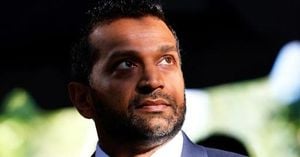At the crossroads of global economic transformation, the BRICS bloc—comprising Brazil, Russia, India, China, and South Africa—finds itself both lauded for its bold ambitions and criticized for its uneven delivery. In recent days, a cascade of developments has thrust the group into the spotlight, with new research, high-level announcements, and persistent questions about its real-world impact converging to paint a complex portrait of a coalition seeking to reshape the world order.
On September 16, 2025, the IX International BRICS Competition Conference convened in Cape Town, South Africa, unveiling research that sent shockwaves through the agricultural sector and beyond. According to IOL Business, a powerful oligopoly of global grain traders—collectively known as ABCD+ and comprising ADM, Bunge, Cargill, Louis Dreyfus Company, COFCO, and Olam—has been exacting a heavy toll on BRICS nations. The study, "From Farm to Futures: Competition, Financialization, and Digitalization in Global Grain Value Chains," revealed that these giants cost BRICS countries a staggering $2.5 billion annually through monopolistic pricing and speculative manipulation. This, in turn, has contributed to rising food prices worldwide and exacerbated hunger, especially in Africa where, as the World Health Organization reports, more than 20% of the population—307 million people—now face food insecurity.
"It is projected that 512 million people could be chronically undernourished by 2030. Almost 60 percent of those will be in Africa," the WHO warned, underscoring the urgency of the crisis. The research highlighted a particularly stark example from Canada, where the merger of Bunge and Viterra led to a 15% increase in grain transshipment costs, draining $412 million annually from producers. Extrapolated to BRICS markets, this could mean an additional $2.5 billion lost each year for countries like Russia and Brazil.
Alexey Ivanov, Director of the International BRICS Competition Law and Policy Centre at HSE University, described the grain market as a "grey zone"—neither fully under state control nor subject to robust market regulation. "Historically, the grain market was predominantly governed through administrative means, particularly before the 1970s and 1980s. Later, market mechanisms and privatisation gained influence, but antitrust regulation remained underdeveloped," Ivanov explained. The result? A system rigged in favor of global traders, who leverage financial infrastructure, privileged access to market data, and coordinated investments to entrench their dominance.
Digital platforms such as Covantis and TRACT have only reinforced this stranglehold, allowing the ABCD+ group to coordinate activity and squeeze out smaller, national competitors—often operating beyond the reach of BRICS antitrust authorities. The study urged coordinated investigations and structural interventions, proposing the creation of a BRICS Grain Exchange as a potential turning point. This exchange, already endorsed by BRICS leaders, could introduce transparent pricing and hedging mechanisms, reducing price volatility and improving competition.
"The experience of competition authorities in the digital sphere has shown that regulatory inaction leads to the entrenchment of dominant players and the proliferation of abusive practices," Ivanov cautioned. "While there is still time, we urge authorities to pay closer attention to the grain sector." South Africa's Competition Commission Commissioner Doris Tshepe attended the conference, marking what could be a pivotal moment in the bloc's battle against agricultural market manipulation.
Yet, for all the urgency and promise, BRICS faces a deeper, more persistent challenge: the gap between its rhetoric and its results. As highlighted in a recent analysis published on September 15, 2025, the group has, since its first summit in 2009, cultivated a significant symbolic presence—championing multipolarity, South–South solidarity, and reform of the international order. The 2025 Rio Leaders' Declaration once again called for "a fairer international financial architecture and the need for IMF quota and governance reform." But as Salzman (2019) and other scholars have observed, the bloc has often been more successful in amplifying its message than in transforming global institutions.
Internal contradictions abound. Russia has consistently sought to position BRICS as a geopolitical counterweight to the West, while India and China have prioritized geo-economic coordination. After 2014, India deepened its ties with the United States, and China launched parallel initiatives like the Asian Infrastructure Investment Bank. This divergence was evident in the cautious language of the 2022 Foreign Ministers’ Joint Statement, which merely "recalled national positions" on Ukraine, reflecting the bloc’s inability to present a unified front during crises.
Efforts to build alternative institutions have yielded mixed results. The New Development Bank (NDB) has approved nearly $33 billion in projects since 2015, but the Contingent Reserve Arrangement (CRA) remains unused. Health initiatives, such as the Tuberculosis Research Network (which covers 40% of the world's TB burden), the Vaccine R&D Center launched in 2022, and the 2025 Partnership for the Elimination of Socially Determined Diseases and Infections, showcase the bloc's capacity to identify challenges, but delivery remains patchy. Labor and education programs, including the SME Action Plan 2025–2030 and the BRICS TVET Cooperation Alliance Charter, promise inclusivity and digitalization, yet systemic integration is still lacking.
Perhaps the greatest obstacle to BRICS’ ambitions is its own diversity. The bloc brings together post-imperial powers (Russia, China) and post-colonial democracies (Brazil, India, South Africa), making unified action both costly and complicated. Despite repeated summit declarations from 2022 to 2025 stressing unity, divergent domestic models and priorities have stymied deeper integration. Even the BRICS Think Tank Council has, year after year, called for IMF and WTO governance reform, climate action, and health system resilience—yet substantive action remains elusive.
Against this backdrop, BRICS is now embarking on its boldest financial experiment yet: the launch of an alternative trading platform designed to accelerate de-dollarization. On September 16, 2025, Russian Foreign Minister Sergey Lavrov announced that the group was moving to exclude the US dollar from cross-border transactions, allowing member states and other emerging economies to use local currencies in trade. "The trend to create alternative platforms as well as payment and logistics mechanisms necessary for normal trade is underway," Lavrov stated, as reported by Pintu News.
This initiative, Lavrov argued, is a direct response to what he described as the US dollar being used as a political tool—one that can harm other countries. He took aim at former US President Donald Trump, claiming that Trump's actions had "caused great harm to the Americans and their position in the global financial system." Lavrov added, "Unfortunately, those in charge of finance in the Donald Trump administration have not yet drawn conclusions from their leader’s judgment." For BRICS, the launch of this platform is more than a technical adjustment; it's a strategic move to reduce US economic dominance and increase the bloc’s role in the global economy.
If successful, the platform could mark a turning point—enabling developing countries to settle payments using their own currencies, reducing exposure to US sanctions and political risks, and fostering a more multipolar economic environment. For many observers, this could be the bold step that finally aligns the bloc’s rhetoric with real-world impact.
Still, the jury is out. As BRICS expands its agenda to include climate finance, AI governance, and public health, the risk of "agenda inflation" grows. The group’s credibility, as many analysts contend, will ultimately depend on its ability to deliver measurable results—not just declarations. Without tangible progress, BRICS risks being dismissed as a forum of lofty promises rather than a true engine of global change. For now, the world watches to see whether this ambitious coalition can close the gap between aspiration and achievement.




